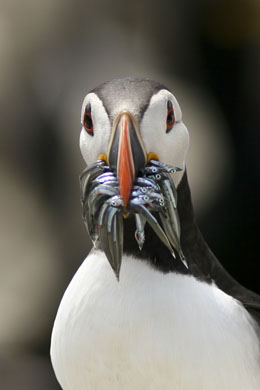One third for the birds

An international group of scientists co-led by the University of St Andrews has shown that many seabirds begin to suffer when the food available for them in the ocean declines below a critical level. This level is about one-third of the maximum amount of food available. They have shown that this critical level is about the same for seabirds wherever they happen to be in the world.
Their study – the most comprehensive ever undertaken – covers birds from the Arctic to the Antarctic and from the Pacific to the Atlantic.
The research, to be published in the journal Science on 23 December 2011, involved scientists from around the world and was co-led by Professor Ian Boyd, Director of the Scottish Oceans Institute, University of St Andrews.
The study focussed upon seabirds that feed mainly on fish like sardines, anchovies and sandeels. These are often key species in marine ecosystems that are sometimes also exploited by fishers. In the Antarctic these fish species are replaced by krill which are like small shrimps. The researchers used data collected from 14 species including guillemots, gannets, skuas, terns, puffins, penguins and a species of gull. Their success at producing chicks was measured over periods of 15 up to 47 years and the team related this to the abundance of their main fish food in the region around their breeding colonies. The study gathered 438 years of observations, which constitutes one of the most comprehensive global databases ever assembled for a predator and its prey.
Wherever it occurred in the world the effect of low fish abundance was similar. When the amount of fish in the sea was greater than one-third of the maximum ever recorded the number of chicks produced was unaffected by changes in food availability. But if the fish abundance fell below this one-third threshold then the success at producing chicks declined.
The team was stimulated to undertake its study by concerns about the effects that fishing may be having upon some of these important species in marine ecosystems.
Professor Ian Boyd said: “When combined with the effects of climate change, we need to develop better methods of setting the limits of exploitation of important marine species. This means being able to establish general guidelines that, if exceeded, will cause changes to other important components in the ecosystems. Seabirds are some of the best and most easily measured indicators we have of the health of these ecosystems and it seems sensible to use them in this context”.
Co-leader of the team, Dr Philippe Cury of the French Research Institute for Development (IRD), said: “We were amazed by the consistency of the relationship around the globe. This suggests that we have found an important benchmark that could be used as a guide to limit the amount of fish taken from the sea in order to maintain seabird populations in the long term.”
The team acknowledges that there is more to be done to understand whether what they have found applies more widely but they think that the rule-of-thumb “one-third for the birds” will be useful as part of wider approaches to making sure that we sustain our marine ecosystems.
The research team comprised scientists from universities and research institutes in the UK, France, Norway, South Africa, the USA, Canada, Sweden and Namibia.
Ends
Issued by the University of St Andrews
Contact : Niall Scott, Director of Corporate Communications, tel 44 1334 462244/462530, mobile 07711 223062, email [email protected]
The full research paper is available to journalists from the Science Press Package team, tel 001 202-326-6440, email [email protected]
Category Research